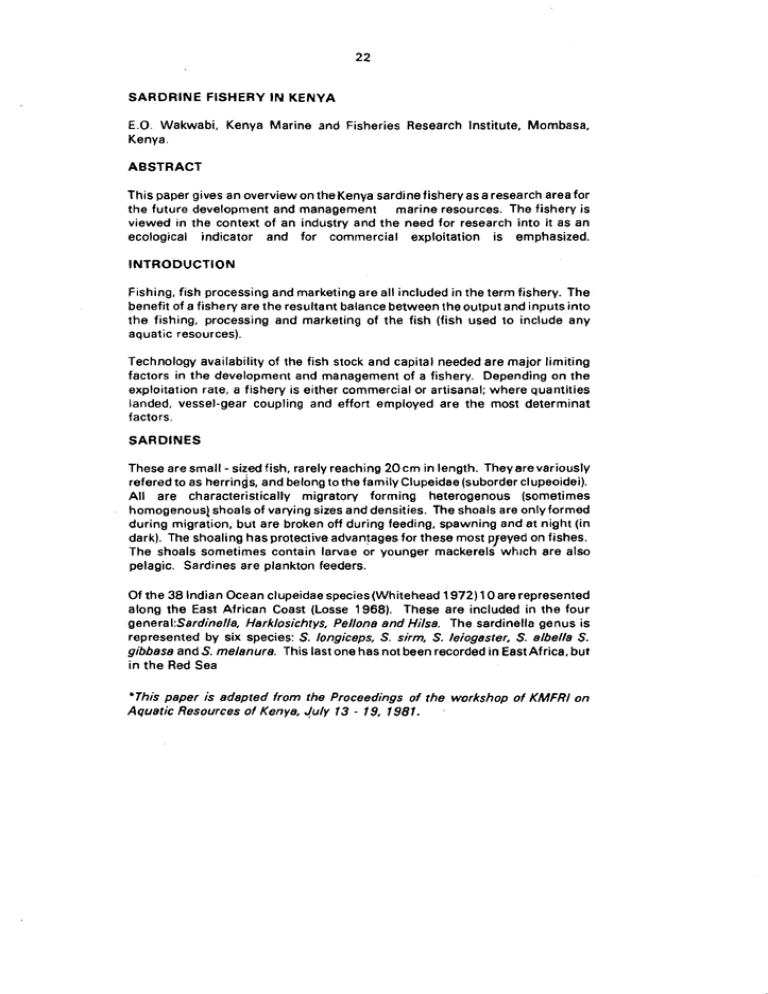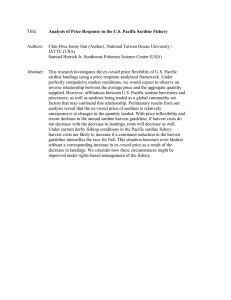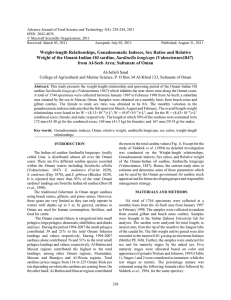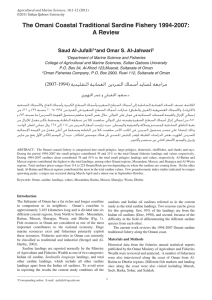SARDRINE FISHERY I N KENYA
advertisement

SARDRINE FISHERY I N KENYA E.O. Wakwabi, Kenya Marine and Fisheries Research Institute, Mombasa, Kenya. ABSTRACT This paper gives an overview on the Kenya sardine fishery as a research area for the future development and management marine resources. The fishery is viewed in the context of an industry and the need for research into it as an ecological indicator and for commercial exploitation is emphasized. INTRODUCTION Fishing, fish processing and marketing are all included i n the term fishery. The benefit of a fishery are the resultant balance between theoutput and inputs into the fishing, processing and marketing of the fish (fish used to include any aquatic resources). Technology availability of the fish stock and capital needed are major limiting factors in the development and management of a fishery. Depending on the exploitation rate, a fishery is either commercial or artisanal; where quantities landed, vessel-gear coupling and effort employed are the most determinat factors. SARDINES - These are small sized fish, rarely reaching 20 cm i n length. They are variously refered to as herrings, and belong to the family Clupeidae (suborder clupeoidei). All are characteristically migratory forming heterogenous (sometimes homogenous) shoals of varying sizes and densities. The shoals are only formed during migration, but are broken off during feeding, spawning and at night (in dark). The shoaling has protective advantages for these most p ~ e y e don fishes. The shoals sometimes contain larvae or younger mackerels which are also pelagic. Sardines are plankton feeders. Of the 38 Indian Ocean clupeidae species (Whitehead 1972) 1 0 are represented along the East African Coast (Losse 1968). These are included i n the four general:Sardinelle, Harklosichtys, Pellona a n d Hilsa. The sardinella genus i s represented by six species: S. longiceps, S. sirm, S. leiogaster, S. albelle S. gibbasa and S. melanure. This last one has not been recorded i n East Africa, but i n the Red Sea "This paper i s adapted from the Proceedings of the wvrkshop of KMFRl o n . Aquatic Resources of Kenya, July 13 - 19, 198 1. (Gulf of Aden) as Herklotsichthys vittatus Whitehead (1965),Losse (1968). The Herklotsichthys genus on the other hand has two species earlier classified as one; H. punctatus forms A and 6. However, these have been renamed separately spilurus ( f o r m A). as H. q u a d r i m a c u l a t u s ( f o r m B ) a n d H. The genus pellona is represented by P. ditchella and Hilsa byH. kelee A l l these species have been described and classified by various workers i n the region. EAMFRO (1962) Losse (1964,1966,1968). Whitehead (1972) and F A 0 (1974). The biology of the sardine (herrings) has also received quite a coverage, though most of the works are outside the East African waters (Blaxter Holliday 1965; Losse 1968). Losse also outlines the spartial distribution and relative occurance and abundance of the sardines along t h e East A f r i c a n coast. Two major sardines found off the Kenya waters are Sardinella gibbosa and Herklotsichthys quadrimaculatus. From market samples all along the Kenyan coast, the two species have been shown t o dominate i n the catchesand seem to alternate i n occurance, but both appearing throughout the year in varying quantities. These two were therefore prefered for the on going research programme on the feeding biology, catch composition, protein content and seasonal variations on which basis, their natural histories are to be constructed. Though, the prevalence of the two species has to be further studied to exploit any existing loopholes and ascertain without doubt which of them dominates the other. A general survey is therefore underway to study the general fishing abilities and methods employed in the sardine fishery. The dominance can otherwise be due to the selective fishing: Preference of species or fishing grounds. RESEARCH Very little can be said on the history of the sardine fishery. Of worth were "night time" catches made during the EAMFRO's surveys w i t h the purse seine i n 1961 (EAMFRO 1961). The catches were as high as one ton per shot (more than three tons per night at anaverage of threeshots per night). The project was t o assess the potential of the shoals and surveys were carried out at daytime. Sardines were found shoaling around the lit up near waters due to bright light from the research vessels and using the purse seine, they were found easily landed in large quantities. The catches varied with time of the year, e.g., off Zanzibar, landings were 90% sardines (Sardinella and Amblygester) i n March but dropped to 25% i n the latter months of the year (EAMFRO 1961). Other research work have since been conducted and taxonomic work have met with success though some have not been fully identified due to lack of proper taxonomic features, especially where only colouration has been used asa major distinguishing feature. For any enterprise, the balance between the costs and the benefits is a major in determining the need for continueddevelopment, management and investment i n the enterprise. It is common practise along the Kenya cost to record amounts and value of fish landed. These records, however, overlook one major aspect i n fishing: the effort employed. It is difficult to evaluate the benefits of the fishery without information on the effort spent to land the fish. Efforts to get any data on this are usually frustrated since the fishermen are not willing to identify themselves. Sardines, however, are an important resource of food to man and other fish. Improving on their fishery can cause an increase in the amount landed andgive rise to a commercial activity. Their stock may also be used to improve on the fishery of, predator fish and of those fish which coexist with them, e.g., mackerels, carangids and scombriods. CONCLUSION Most of the Literature on the sardines is based on fisheries outside our waters. Fisheries on the Herring, Clupea harengus L.; Califonian sardine, Sardine caerulea Girard; the Indian oil sardine, Sardinella longiceps (Val); the Japanese sardine, Sardinops melanosticta Schlegel, and the European sardine, Sardine pilchar dus Walbaum, to mention but a few are good examples of various works on the great fisheries of the world. A research programme at the Kenya Marine and Fisheries Research Institute, Mombasa, has been undertaken to study the life histories of sard~nes(clupeidae) of the Kenyan coast. lnformatiorl on the seasonal variations (size and catch composition), is being gathered for the evaluation of the factors influencing their distribution. Taxonomic works are also being undertaken though earlier investigations as. those undertaken by among others, Losse (1968) and Whitehead (1972) are acknowledged here. There is need for a deeper insight into the biolcjgy of the sardines as this would help us undersatandother surface schoaling fish which depend on sardines for food. Of importance is the migration patterns which reflect hydrographic changes and fluctuations of fish sizes. , Stomachs of Sardinella gibbosa and Herklotsichthys quadrimaculatus are being examined for foodoontent. Theoccurance and points methods(Hynes 1950)are employed in the study of the stomach contents. Thetwo meihodswereprefered due to the smallness of'the stomachs andtheforageorganisms. By giving some arbitrary figures to the observed stomach (volume or degree of fullness and its contents analysed into specific forage organisms the time and frequency of feeding and forage organismsas relatively fedon will be deterined. Thiscoupled with data on zoo-plankton in the fishing ground are useful information. Data is also being gathered from market samples on catch compositions (by size, species, sex, age etc.). 25 REFERENCES 1. Blaxter, J.H.S. and Holliday, F.G.T. (1965). The behaviour and physiology Adv. Mar. Biol. 1 : 262-372 of herring and other clupeids. 2. East African Marine and Fisheries research Organizations (EAMFRO) (1 953). Annuad Report. 3. ............., (1 961 ). Annual Report 4. ............. (1962). Annual Report. 5. F.A.O. (1 974). Monitoring of fish stock abundance, the use of catch and effort data. Fishe~iesTechnical paper no. 155, FIRS/T155 102 pp. 6. Hynes, H.B.N. (1950). The food of the freshwater sticklebacks, Gasterosteus aculeatus and Pygosteus pungitius: A review of methods used in the studies of the food of fishes. J. Anim. Ecol. 1 9 : 36-58. 7. Losse, G.F. (1964). Report. 9. ......... (1966). Check list of elopoid and clupeoid fish of E.A. Coastal waters. J. East Afr. Nat. Hist. Soc. Net. Mus. 25 (3) : 166 - 178. -- S a r d ~ n elnvesrigations : 1 1-12 EAMFRO Annual 9. Losse G.F. (1968). The elopoid and clupeoid fish of East African Coastal waters: J. East Afr. Nat. Hist. Soc. Nat. Mus. 2 7 (2) : 77 - 115 10. Whitehead, P.J.P. (1972). A synopsis of the clupeoid fish. India J. Mar. Sci. 1 4 (1): 1 6 0 - 256 1 1 . Whitehead, P.J.P. (1 965). A Review of the elopoid and clupeoid fish of the Red Sea and adjacent regions. Bull. Hist. (Zool) suppl. 2:4-782 CATCHES Data o n sardine landings along t h e Kenya coast show seasonal flactuations w i t h drastic variations w h i c h reflect t h e impact of weather changes. Of particular interest is t h e synchrony between the abundance of sardines o n t h e market during t h e November-April period w h e n t h e Northeast (NE) Monsoons prevail along t h e coast. During t h e same season analysis o n the primary productivity and plankton abundance have s h o w n peaks. L o w catchesduring the remaining part of t h e year s h o w the impact of t h e prevailing Southeast (SE) Monsoons. It is noted that d u r ~ n gt h e NE Monsoons, a n upwelling developes in t h e northern Kenya banks w h i c h should b e contributing to t h e productivity level during t h e season. Information provided by t h e Fisheries Department o n monthly landings (for 1 9 7 9 and 1980) show seasonal fluctuations i n catches (figure 1. 2 and 3. Percentage of sardines landed to total landings indicate that during the good fishing season (NE Monsoons) w h e n rains are heavy and long, the sardine landings are high. Figure 2 gives t h e landings i n metric tonnes per month. During t h e SE Monsoons (May - October) w h e n t h e conditions are rougher due to strong winds there is a fall i n grand catches (figure 3). The l o w catch during the period is attributed t o either lack of fish stock or difficulty of operating local craft i n rough waters. The landing of sardines, therefore, depends o n skilled operations: The ability (of t h e fisherman) to identify surround and trap a shoal i s a major advantage. The EAMFRO annual report recommended t h e use of purse seines for shoaling pelagic fish as t h e only way t o commercially exploit t h e fishery (EAMFRO 1953). 1 J F I ~1 lllllllLv? F M A M J J A S O N D Months A dorect comparlson of the sard~neland~ngs to grand total land~ngsby months for the years 1979 & 1980 Note the peak Key - - 2 20 a) .C-10- 2 I J F M A M J J A S O Months Fig.2. Sardine landings along Kenya coast i n metric tonnes (1979 & 1980). N D 900- 5 800 - C + -E 600 - :. 700 C a, -., 200 - W 1980 0 100- >o( 0 +- z , J I F I M I A I I I I I I I M J J A S O N Months Fig.3 Grand total landings of fish along Kenya coast i n metric tonnes. (1979 - 1980) 1979 I D








